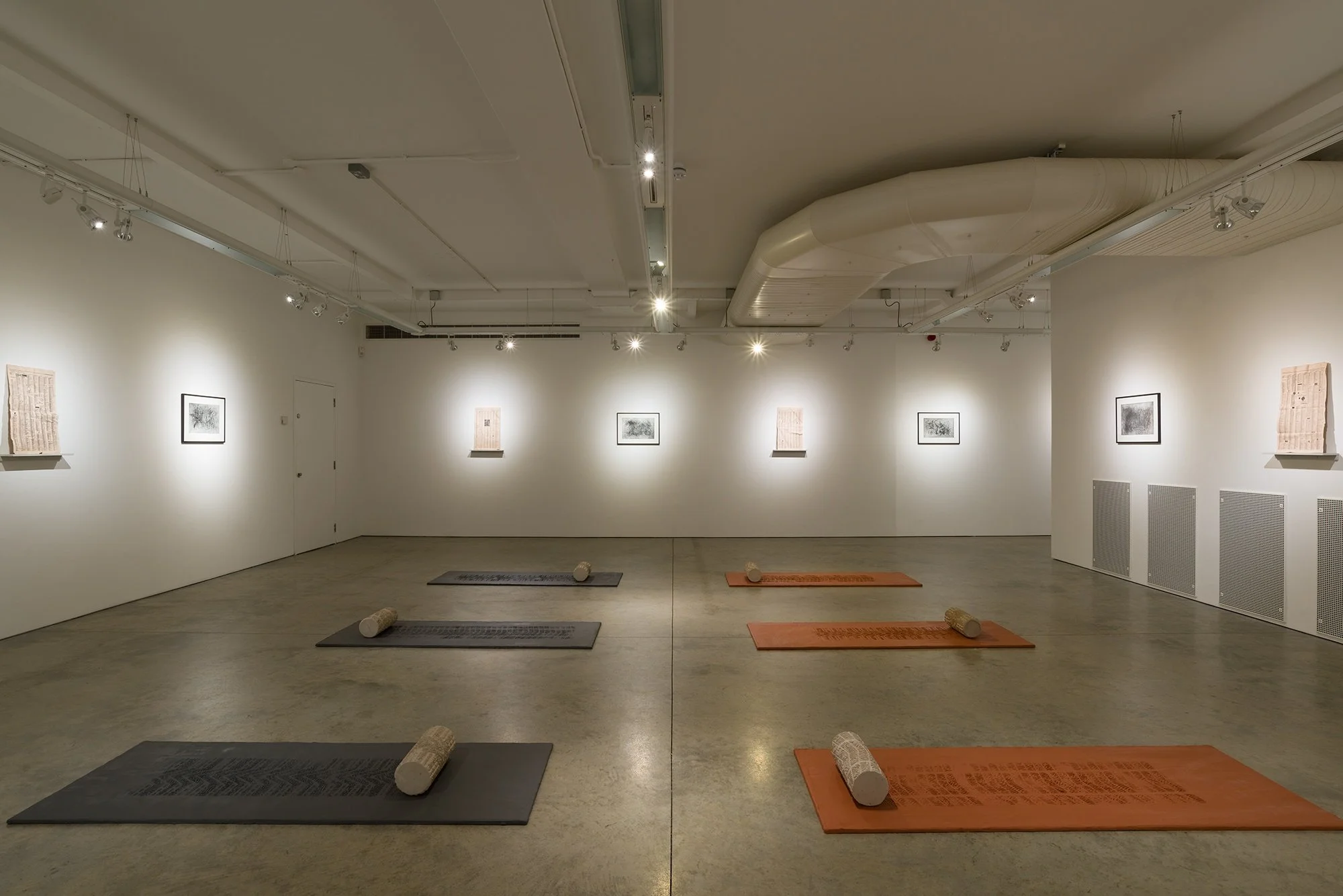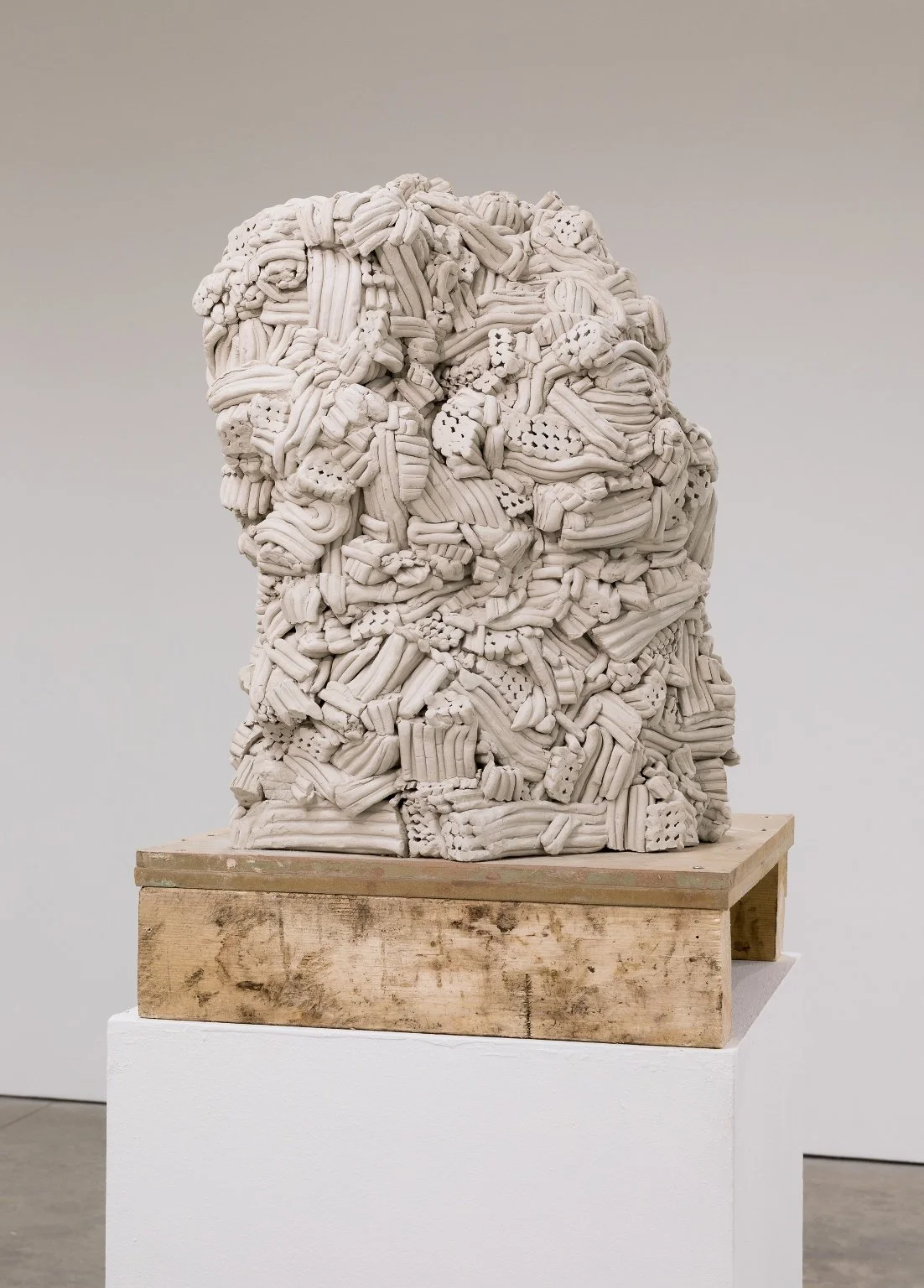Nathan Anthony

“My interest becomes about ‘how’ rather than ‘how well’ something has been made; it gives me an indifference towards right and wrong.”
Nathan Anthony is a British sculptor whose work explores process, material logic, and the blurred line between the handmade and the mechanised. In this interview, he discusses his approach to repetition, gesture, and invented fabrication systems, as well as how different bodies of work relate to each other within an exhibition space.
Could you tell us a bit about yourself and your background?
I’m from the UK. I was born in West Sussex to Belgian and South African parents. I grew up in commuter-belt Kent with my mother and later inner London with my father. I’m not intentionally trying to mine anything from my childhood for an artistic origin story, but I’ve come to think of it as somewhat significant that I really enjoyed attempting to impersonate accents as a child. Art at school felt like a distinct learning experience that wasn’t just copying off the board or being told information. It was embodied and happened by doing. It felt like you could have a personal stake in it. I wanted to keep pursuing that feeling so I studied for a joint art-practice and history of art degree at the University of Edinburgh finishing in 2014. After that I worked various odd jobs; oriental carpet cleaner, hospitality staff, gallery invigilator, a failed stint at the BBC, and eventually as an artist-in-residence and art teacher in three different schools. This was a productive period as I was able to use their facilities to make my own work and keep developing my practice. I went to the United States to pursue an MFA at The University of Texas at Austin in 2023, graduated in May this past summer, and am based in Austin for now.
Your sculptures often play with weight, texture, and balance, materials that seem both industrial and handmade. What draws you to exploring these physical contrasts?
I think anxiety surrounding proficiency in some traditional skills has often led me to invent strategies that mediate or mechanise my fabrication processes. For me, these invented techniques lessen the burden or relieve pressure on the ‘artist’s hand’ both conceptually (in relation to value judgments) and literally (when there is a lot to do!). My interest becomes about ‘how’ rather than ‘how well’ something has been made; it gives me an indifference towards right and wrong. This lower stakes studio environment frees me up, lets me take risks and get lost in what I am doing. I want the will of Juhani Pallasmaa’s ‘thinking hand’ to emerge. An example is an ongoing series of works in which I hand build various forms (like blocks and mounds) out of clay that has been extruded through a metal die designed to recreate the ridged profile of a modelling plasticine called Newplast. It's a tragicomic attempt by an individual to do the impossible job of an entire factory, or a rogue employee misusing company machinery for their own ends. I’m intrigued by what comes out of these fordist glitches or factory errors. What shape can a herniated disc bulging from the spine of capitalism take?
Muscled Memory, 2021, Photographer: Reinis Lismanis
Muscled Memory, 2021, Photographer: Reinis Lismanis
Calendar Object, 2025, Photographer: Alex Boeschenstein
Several of your works seem to record traces of physical action, pressing, looping, folding: Where process becomes part of the form itself. How important is repetition and gesture in the way your work develops?
They are both very significant. I rarely make one of something. Repetition is important because often I am figuring out how to make something for the first time, so it takes a few attempts, each a little better than the last. I might not know why I’m doing something, or what I want when I’m starting, but I find I can distill and clarify my intentions through this repetitious process. That is why I’ve often been drawn to iterative processes like casting and printmaking that generate multiples. They promote thinking through making and allow me to see different possible versions. I’ve handled gesture in different ways. I mentioned bypassing the ‘artist’s hand’ already. Often it's been about making visible anonymous indexical marks that record time and indicate someone else's presence as a stand in for myself. For instance I’ve made intaglio prints of used chopping boards from the kitchens of a school I worked at. They were impressions of expression. More recently I did the same thing with metal kickplates taken from the bottom of doors in the building where I was studying. But sometimes my own gesture is present. A work like ‘Calendar Object’ is an example of that. I repeatedly stacked circular mig welds on top of each other to incrementally build up a long and spindly organic form in steel.
Many of your installations create a quiet dialogue between objects, as if each piece is responding to another. How do you think about the relationships that form between your works in space?
I’ve always thought of myself as a drag and drop artist in that I’m generally hyper focused on the practicalities of making the thing itself and not on how it will be exhibited. Compromising my work flow by attempting to simultaneously make curatorial decisions seems like such a crass inconvenience. I’ve got horse-blinkered tunnel vision until it's complete and self-sufficient. Then I finish and it won’t fit out the studio door! I do tend to work on different series concurrently so I can bounce back and forth between them when I get stuck or bored. Resolving one work might happen in the background whilst working on another. There's a porousness to working like this and different works can end up influencing each other even if their origins and materials are unrelated. These unwitting relationships that germinate in the studio perhaps crystallize in an exhibition setting when everything is shown together, but it takes some distance and hindsight for them to be visible. Recently I’ve found that Charles Sanders Pierce's sign categories; icon, index and symbol are a helpful way to think about works with distinct representational modes all sitting together in space. Circling back to liking impressions, I seem drawn to adopting a different visual language for each project. They are Trojan horses. It's like one voice, splintered into regional accents, trying to harmonize in space. Hopefully that creates a productive dissonance.
Raw Meat, 2021, Photographer: Reinis Lismanis
Stack, 2025, Photographer:Baptiste Despois
White, 2022, Photographer: Joseph Konczak
Untitled, 2023, Photographer: Reinis Lismanis
Untitled, 2023, Photographer: Reinis Lismanis (detail)
Tell us a bit about how you spend your day / studio routine? What is your studio like?
I'm in a transitional stage as I just finished an intense period of study and am figuring out my next steps. I don’t have my own studio at the moment, but I’m an adjunct lecturer teaching sculpture classes at a university, so I have access to the facilities there. If I’m working on something, I normally do it after classes when it's emptier. In the past few years I’ve been lucky enough to have had consistent access to tools and specialist equipment through my employment, but I do worry about becoming completely institutionalised and overly reliant on these resources. I think it's important to stay supple and be able to respond to any environment. I’ve also made ongoing works that require very little; collecting abraded pool cue chalks from bars, repairing used scratchcards with silver leaf, sticking sand from different beaches to entire rolls of sellotape. I’d like to use these untethered approaches more often. Plenty of things from just being in the world feed into my practice somehow. In particular, walking and noticing things. Rebecca Solnit suggests its rhythm is the pace of thinking. Photographing urban flotsam and jetsam, jotting down fragments of thought. Cycling is a way I love to experience a city, and by public transportation. It sounds weird but I like commuting, it's just stolen time to daydream. Listening to the radio is very important to me, especially in the evening.
What artwork have you seen recently that has resonated with you?
I recently revisited the purpose-built gallery for Cy Twombly’s work at the Menil Collection in Houston. His sculptures in particular always move me. At the Museum of Fine Arts Houston I saw plenty I wasn't previously aware of. A photogram by Zana Briski that was made in situ at night and captured the profile of black bear in motion. A large draped fabric form cast in bronze by Joseph Havel. Harry Bertoia’s delicate brazed brass rod constructions. I do become aware of a lot of art online. Lately, I was excited reading about Kara Walker’s subversive new sculpture ‘Unmanned Drone’ which is a disassembled and reconfigured Confederate bronze equestrian statue. I wish I could have seen June Crespo’s exhibition ‘Danzante’ at Secession in Vienna in person. Her sculptures looked impressively guttural and uncompromising. There's plenty of younger artists I admire. The inflatable latex sculptures of a French artist called Ken Sortias beguile me. I love the quiet cast aluminium works of London based Mathew Peers. I felt very energised coming across the practice of Sophie Friedman-Pappass. In particular her ‘Kiln Building’ works, which are a series of bespoke kilns shown as charred sculptures after being fired. Tangentially, I also recently learned about an older Danish ceramicist called Nina Hole who’s ‘Fire Sculptures’ were monumental forms constructed and fired on-site by wrapping them in fibre blankets.
Is there anything new and exciting in the pipeline you would like to tell us about?
Back in August I made some large unfired clay sculptures on wooden palettes using an extruder in situ at McLennon Penn gallery in Austin as part of a duo exhibition titled ‘Ortland Leathe’ with an artist called Selina Wagner. Unfortunately I had to destroy them at the end of the show as they were too fragile and cumbersome to be transported to a kiln. I have just started a ceramics residency at The Dougherty Arts Center in Austin and I’d like to use my time there figuring out how to fire this type of large scale work.
All images courtesy of the artist
Interview publish date: 20/11/2025
Interview by Richard Starbuck







